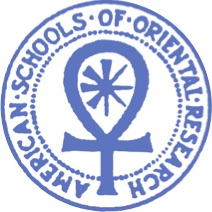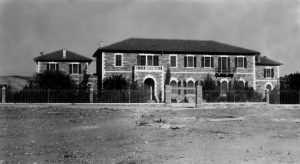
A History of ASOR: The Jerusalem School
In the previous post on ASOR’s history, we concluded with the incorporation of ASOR as an organization in the United States. It was in 1921 that ASOR received its name as the American Schools of Oriental Research. This name change signified that the scope of research, both geographically and historically, was greatly expanded from the original goals of the organization in the Levant. To mark this change, ASOR adopted a new seal that was in use until 2017.This seal consisted of the “Egyptian ankh hieroglyph, the symbol of life, containing within it the Babylonian dinger, the eight-pointed star formed by four cuneiform wedges, signifying deity.” (Meyers 2001; 11).
ASOR’s incorporation was soon followed by the construction of a permanent facility in Jerusalem. In 1917, Mrs. James B. Nies gave a gift of $50,000 to construct a building on land that had been acquired in 1909. Construction finally begin in 1924 under the direction of William F. Albright, ASOR’s Director until 1929. The design of the school was selected from submissions to a contest held at Yale School of Architecture. Under supervision of Elias T. Gelat, the first of three buildings was completed in 1924. The Annual Professors building, the Main Building, and the Director’s House were all completed by 1931. These new structures provided housing for members of ASOR’s staff and an additional 10 rooms to host scholars (Meyers 2001; 11).
The new Jerusalem School was only able to operate for a few years before the outbreak of World War II. The conflict ceased all travel and research based out of the Jerusalem School. ASOR faced further difficulties to scholarship with “the establishment of the State of Israel and the Hashemite Kingdom of Jordan” in 1948 (Meyers 2001; 22). With the Jerusalem School now within the area under Jordanian jurisdiction, ASOR resumed its research activities with multiple archaeological projects throughout the Levant. The multitude of projects undertaken by ASOR from 1950 to 1967 include, “Dhiban, Tell-es Sultan, Khirbet Qumran, Bethel, the Buqe’ah, Petra, el-Jib Shechem, Beth-Zur, Pella, Ghassul, Araq el-Emir” and many others (Meyers 2001; 23). Perhaps the most famous of ASOR’s research activities was the identification of the Dead Sea Scrolls in 1948.
Despite ASOR’s prolific research based out of the Jerusalem School, plans were made to sell the property due to its increased value. This plan was an attempt to solve financial difficulties that ASOR faced in the Spring of 1967. However, this never came to pass as the Six-Day War broke out and the Jerusalem School was now under the jurisdiction of the Israeli State. The aftermath of the Six-Day War saw an “Arab boycott of all scholars working in Israel” (Meyers 2001; 30). This meant that researchers who chose to work in Israel could not also work in Jordan or Syria.
This led to a very serious dilemma facing ASOR scholars who had previously worked throughout the entire region. In 1970 it was decided the best course of action was to create two separate institutions, one in Jordan and the other in Israel. From this resolution, the American Center for Oriental Research (ACOR) was established in Amman. Subsequently, in 1970 the Jerusalem School was reincorporated as the W.F. Albright Institute of Archaeological Research (AIAR). This saw the end of the Jerusalem School as administered by ASOR and the buildings were fully turned over to AIAR in the 1990’s. Today you can visit ASOR’s former home in Jerusalem by visiting the Albright. AIAR and ACOR continue to thrive as institutions with whom ASOR has continued close ties and working relationship.
Stay tuned for the next installment on the history of ASOR! Thank you to Joe Seger for his continued input to this series on ASOR’s history.
Sources:
Meyers, Eric M. and Joe D. Seger. 2001. ASOR: A History of the American Schools of Oriental Research. In An ASOR Mosaic, edited by Joe D. Seger, pp. 2-103. American Schools of Oriental Research, Boston.
American Society of Overseas Research
The James F. Strange Center
209 Commerce Street
Alexandria, VA 22314
E-mail: info@asor.org
© 2023 ASOR
All rights reserved.
Images licensed under a Creative Commons Attribution-NonCommercial-ShareAlike 4.0 International License
COVID-19 Update: Please consider making payments or gifts on our secure Online Portal. Please e-mail info@asor.org if you have questions or need help.

